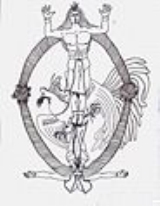
Philippine mythical creatures
Encyclopedia
Philippine folklore, unlike Greek
or Roman
mythologies
, has not been organized into a formal pantheon, does not generally contain long epics
, nor has it been relegated to history. To this day, Philippine myths still have an active role in the lives of rural Filipinos. The countless myths circulating throughout the Filipino countryside contain a large variety of mythical creatures. Although there is no scientific evidence for any of these creatures, there is also no shortage in the rural parts of the Philippines of people who believe firmly in their existence. This discrepancy is sometimes rationalized by the explanation that only pure and good mortals are able to see these creatures.
to explain the world around them. Before science and empirical reasoning
, myths and legends served mankind by invoking the supernatural to interpret natural events, to explain the nature of the universe, and shed light on the purpose of existence. Filipino mythology is no different. Filipino legends contain a broad spectrum of stories including legends recounting the birth of the Philippine islands, as well as accounts of supernatural creatures that are sometimes invoked to inspire fearful obedience in children or explain disease.
Bungisngis is a one-eyed giant. This Philippine folklore giant lives in forest and woods. It is a happy and a playful cyclops. It is also commonly known as 'Mahentoy' in the northern part of Davao.

Bathala, Diyos
or Apo
it is the creation god in Filipino myths.
(from Spanish: encantada, "enchantress, charmed") or engkanto
(from Spanish: encanto, "spell, incantation, charm") are fairies, nymphs, goddesses or enchanted persons who are believed to guard natural creations such as forests, seas, mountains, land and air. Diwatas are said to reside in large trees, such as acacia
and balete
. They are the guardian sprits of nature, bringing blessings or curses upon those who do good or harm to the forests and mountains. One famous diwata is Maria Makiling
, guardian of Mount Makiling
in Laguna province. Engkanto (sometimes spelled Encanto) is an umbrella term for most supernatural beings. The common connotation is that they are fairies who reside primarily in the forests and the sea. They can also be called encantado (male) or encantada (female).
: duende
"golbin, elf, charm" < "duen de (casa)", owner of the house). They are little creatures who can provide good fortune or bad fate to humans. In the Philippines, duwendes frequently live in houses, in trees, underground, termite like mound or hill, and in rural areas. They are known to be either good or mischievous, depending on how homeowners treat them. They usually come out at 12 noon for an hour and during the night. Filipinos always mutter words ("tabi-tabi po" or "bari-bari apo ma ka ilabas kami apo") asking them to excuse themselves for bothering the Duwendes. Filipinos would leave food on the floor, so that the duwende residing (or guarding) the house would not be angry with them.They also take your things,and laugh at you when you try to find it.They give it back when they feel like it,or when you tell them to please give it back.
are creatures who are bird-like humans. They are winged-humans who at night search for victims. They hunger for flesh and blood. In American Literature, it is like a vampire.

Juan Tamad is a lazy man who was buried under the soil by monkeys. The monkeys thought he was long dead because of his laziness. He is described as the laziest man on earth.
is a filthy, dark giant
who likes to smoke huge rolls of cigars, and hide within and atop large trees, particularly the balete
and old acacia or mango trees. A Filipino bigfoot
, it scares away little children who play at night. If you're stuck in a place and you keep going around in circles, you're said to be played around by a Kapre. To escape its control, you must remove your t-shirt, and wear it inside-out.
 Malakas and Maganda (literally, Strong One and Beautiful One) are Filipino version of Adam and Eve
Malakas and Maganda (literally, Strong One and Beautiful One) are Filipino version of Adam and Eve
. They are said to have sprung from a large bamboo tree pecked by a Sarimanok known as Magaul.
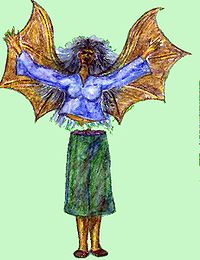
Manananggal is an aswang that can fly after separating itself from the lower half of its body. It eats babies and fetuses from a mothers womb. It eats babies by means of passing their long tongue through a small hole from the roof of a house. The sharp end of the tongue touches the mother's navel to suck the blood of the fetus or unborn child. This creature's name was derived from the Filipino word, tanggal, which means "to separate" because of the manananggal's ability to separate itself from its lower body.
A manananggal can also be a sorceress that visits villages and barrios. To feed, the self-segmenter chooses an isolated place where she will leave her lower torso while she hunts at night. When she separates from her lower torso, she then gains her ability to fly. She then goes off in search of houses where pregnant women reside. Upon choosing a suitable victim, the Manananggal alights on the house and inserts her tongue through the roof. The tongue is long, hollow and extremely flexible. She uses it to puncture the womb of the sleeping woman and to suck out the fetus. At other times, she seduces men with her beauty and lures them to a private place before eating them alive. She usually eats the insides, like the heart, stomach or the liver. Sunlight is deadly to the Manananggal when she is in her monstrous form. Should her two halves still be separate with the coming of dawn, she will be destroyed. According to legend, to destroy the Manananggal, one should search for the lower torso that she leaves behind during her nightly hunts. Salt, ash, and/or garlic should then be placed on the exposed flesh, preventing the monster from combining again and leaving it vulnerable to sunlight. Small containers of salt, ash and raw rice, and the smell of burning rubber are said to deter the Manananggal from approaching one's house.
is a mythical king who became a bird. He was believed to have caused the seas and the skies to fight against each other. The clash between the seas and skies resulted to the formation of the Philippine island
s.
The difference between a mambabarang and a mangkukulam is that the mambabarang uses magical insects to bring harm to his victims. These insects are released after incantations, when they will search for their supposed victim and burrow under the skin, impregnating her. After some time, matruculans return to the house to kill the pregnant mother, open her abdomen, and eat the growing fetus.
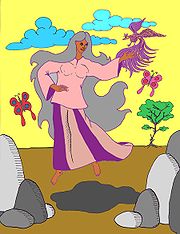
Mariang Makiling is a fairy who dwells atop Laguna's Mount Makiling
, an inactive volcano. Oral tradition described that Mount Makiling was once a castle and Mariang Makiling was a princess who fell in love with a mortal.
, comes from the Spanish word muerto, which means "dead". Superstitious Filipinos believe that some kind of multo, often a spirit of their former kin, regularly visits them.
). They can provide a person who steps on their shelter with good luck or misfortune. Superstitious Filipinos, when passing by a mound, will ask the resident nuno's permission to let them pass with the phrase, "Tabi-tabi po". Strange and sudden illnesses that befall a person are sometimes attributed to nunos.
. It was scientifically explained as electric fields which have diverged from the lines. However, the sightings were reported since the Spanish era (16th-19th centuries). (See also Shinen and Will-o-Wisps
) There were also sightings in the Alps
and Himalayas
.
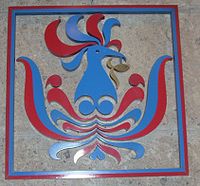
A Sarimanok is a magical, mythical bird who brings good luck to anyone who are able to catch it. A Sarimanok known as Magaul is associated with the legend of Malakas and Maganda. Magaul was the Sarimanok bird that pecked the bamboo from where Malakas and Maganda were born from.
 Sirena
Sirena
is a mermaid
, a sea creature with a human upper body and a fish tail instead of lower extremities. They attract fishermen and tourists. Sirenas are reportedly often seen ashore by fishermen, especially in the towns bordering the Pacific Ocean
.
, sea creatures that have a human form and scaled bodies. The Siyokoy is the male counterpart of the Sirena. The lower extremities of a Philippine merman can either be a fishtail or scaled legs and webbed feet. They could also have long, green tentacles. They drown mortals for food. Siyokoys have gill slits, are colored brown or green, and have scaly skin, comparable to that of a fish.
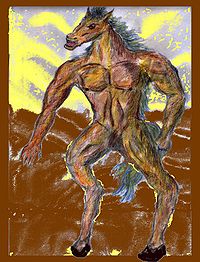 Tikbalang or tigbalang (demon horse) is a half-man and half-horse creature. It has a horse's head, the body of a human but with the feet of the horse. It travels at night to rape female mortals. The raped women will then give birth to more tikbalang. They are also believed to cause travelers to lose their way particularly in mountainous or forest areas. Tikbalangs are very playful with people, and they usually make a person imagine things that aren't real. Sometimes a Tikbalang will drive a person crazy. Legends say that when rain falls while the sun is shining, a pair of Tikbalangs are being wed. Since horses only arrived in the Philippine archipelago during the Spanish colonization (thus, the borrowed term 'kabayo'), there is a theory that the image of a half-horse, half-man creature was propagated by the conquistadors to keep the natives afraid of the night. There are stories claiming that the Tikbalang are actually half-bird, half-man creatures, much like the Japanese tengu
Tikbalang or tigbalang (demon horse) is a half-man and half-horse creature. It has a horse's head, the body of a human but with the feet of the horse. It travels at night to rape female mortals. The raped women will then give birth to more tikbalang. They are also believed to cause travelers to lose their way particularly in mountainous or forest areas. Tikbalangs are very playful with people, and they usually make a person imagine things that aren't real. Sometimes a Tikbalang will drive a person crazy. Legends say that when rain falls while the sun is shining, a pair of Tikbalangs are being wed. Since horses only arrived in the Philippine archipelago during the Spanish colonization (thus, the borrowed term 'kabayo'), there is a theory that the image of a half-horse, half-man creature was propagated by the conquistadors to keep the natives afraid of the night. There are stories claiming that the Tikbalang are actually half-bird, half-man creatures, much like the Japanese tengu
.
, a chamber of Hell
which unbaptized dead people fall into, and are transformed into evil spirits. These phantasms return into the mortal realm in the form of goblins to eat living victims. The tiyanak can also be the offspring of a woman and a demon. It can also be an aborted fetus which comes back to take revenge on its mother. Most Tiyanaks are said to live in forests. If they see a human, they transform into what looks like a normal baby. When the person notices the Tiyanak and comes near to take a look at it, the Tiyanak changes back to its true form and eats its prey.
Greek mythology
Greek mythology is the body of myths and legends belonging to the ancient Greeks, concerning their gods and heroes, the nature of the world, and the origins and significance of their own cult and ritual practices. They were a part of religion in ancient Greece...
or Roman
Roman mythology
Roman mythology is the body of traditional stories pertaining to ancient Rome's legendary origins and religious system, as represented in the literature and visual arts of the Romans...
mythologies
Mythology
The term mythology can refer either to the study of myths, or to a body or collection of myths. As examples, comparative mythology is the study of connections between myths from different cultures, whereas Greek mythology is the body of myths from ancient Greece...
, has not been organized into a formal pantheon, does not generally contain long epics
EPICS
The Experimental Physics and Industrial Control System is a software environment used to develop and implement distributed control systems to operate devices such as particle accelerators, telescopes and other large experiments. EPICS also provides SCADA capabilities...
, nor has it been relegated to history. To this day, Philippine myths still have an active role in the lives of rural Filipinos. The countless myths circulating throughout the Filipino countryside contain a large variety of mythical creatures. Although there is no scientific evidence for any of these creatures, there is also no shortage in the rural parts of the Philippines of people who believe firmly in their existence. This discrepancy is sometimes rationalized by the explanation that only pure and good mortals are able to see these creatures.
Purpose of Philippine mythological creatures
Traditionally, people create mythologyMythology
The term mythology can refer either to the study of myths, or to a body or collection of myths. As examples, comparative mythology is the study of connections between myths from different cultures, whereas Greek mythology is the body of myths from ancient Greece...
to explain the world around them. Before science and empirical reasoning
Empirical method
The empirical method is generally taken to mean the approach of using a collection of data to base a theory or derive a conclusion in science...
, myths and legends served mankind by invoking the supernatural to interpret natural events, to explain the nature of the universe, and shed light on the purpose of existence. Filipino mythology is no different. Filipino legends contain a broad spectrum of stories including legends recounting the birth of the Philippine islands, as well as accounts of supernatural creatures that are sometimes invoked to inspire fearful obedience in children or explain disease.
Bungisngis
Maria is a ghost girl who was transformed into a beautiful plant and was killed from her step mother and sisterBungisngis is a one-eyed giant. This Philippine folklore giant lives in forest and woods. It is a happy and a playful cyclops. It is also commonly known as 'Mahentoy' in the northern part of Davao.
Aswang
Aswangs are shapeshifters. They are human-like by day but transform into different monstrous forms to harass and eat awake humans at night, especially pregnant women who are about to give birth. Aswangs can change from a human to an animal form, usually as a bat, a pig or a black dog. Some aswangs can change form at will, others through the use of foul oils concocted by evil magicians. Aswangs appear at night to prey upon unwary travellers or sleeping people. It is said that they have a peculiar liking for the taste of human liver. The myth of the Aswang is popular in the Visayas, especially in provinces such as Capiz, Antique, and Iloilo. Aswangs also have a peculiar liking for the fetus of pregnant women and are said to find their quarry by the scent of the mother, which to the aswang smells like ripe jackfruit. Upon finding the house of the pregnant mother, the aswang alights on the roof from where it stretches its tongue until it is as thin as a thread and uses it to enter the womb and feast on the fetus.Bathala

Bathala, Diyos
God (male deity)
A god, as a male deity, contrasts with female deities, or "goddesses". While the term 'goddess' specifically refers to a female deity, the plural 'gods' can be applied to all gods collectively, regardless of gender....
or Apo
Bathala
In ancient Tagalog Theology Bathala was the Supreme Being; the Omnipotent Creator of the universe. Antonio de Morga, among others, thought that Bathala meant an omen bird , but the author of the Boxer Codex was advised not to use it in this sense because they did not consider it God but only his...
it is the creation god in Filipino myths.
Diwata
Diwata, engkantadaDiwata
In Philippine mythology, a Diwata , also known as Encantada, is a mythological figure similar to fairies or nymphs. They are nature spirits and live one with mother earth...
(from Spanish: encantada, "enchantress, charmed") or engkanto
Engkanto
Engkanto are environmental spirits that have the ability to appear in human form. They are often associated with the spirits of ancestors in the Philippines. They are also characterized as forest spirits or elves...
(from Spanish: encanto, "spell, incantation, charm") are fairies, nymphs, goddesses or enchanted persons who are believed to guard natural creations such as forests, seas, mountains, land and air. Diwatas are said to reside in large trees, such as acacia
Acacia
Acacia is a genus of shrubs and trees belonging to the subfamily Mimosoideae of the family Fabaceae, first described in Africa by the Swedish botanist Carl Linnaeus in 1773. Many non-Australian species tend to be thorny, whereas the majority of Australian acacias are not...
and balete
Balete
Balete can refer to:*The modern name for the baMalete, a Southern African Tswana tribe.*The Banyan Tree, locally known as 'Balite' or 'Balete' in the Philippines and closely associated with the spirit world according to a number of Philippine Myths, or any species of Ficus in general*Balete, Aklan,...
. They are the guardian sprits of nature, bringing blessings or curses upon those who do good or harm to the forests and mountains. One famous diwata is Maria Makiling
Maria Makiling
Maria Makiling, sometimes spelled Mariang Makiling, in Philippine Mythology, is a diwata or lambana associated with Mount Makiling in Laguna, Philippines...
, guardian of Mount Makiling
Mount Makiling
Mount Makiling, also rarely Mount Maquiling, is a potentially active volcano in Laguna province on the island of Luzon, Philippines. It rises to 1,090 m above mean sea level.-Legend:...
in Laguna province. Engkanto (sometimes spelled Encanto) is an umbrella term for most supernatural beings. The common connotation is that they are fairies who reside primarily in the forests and the sea. They can also be called encantado (male) or encantada (female).
Duwende
Duwende are goblins, hobgoblins, elves or dwarfs (SpanishSpanish language
Spanish , also known as Castilian , is a Romance language in the Ibero-Romance group that evolved from several languages and dialects in central-northern Iberia around the 9th century and gradually spread with the expansion of the Kingdom of Castile into central and southern Iberia during the...
: duende
Duende (mythology)
A duende is a fairy- or goblin-like mythological creature from Iberian, Latin American and Filipino folklore. While its nature varies throughout Spain, Portugal, Spanish and Portuguese-speaking America and the Philippines, analogues from other cultures include the Danish-Norwegian Nisse, the...
"golbin, elf, charm" < "duen de (casa)", owner of the house). They are little creatures who can provide good fortune or bad fate to humans. In the Philippines, duwendes frequently live in houses, in trees, underground, termite like mound or hill, and in rural areas. They are known to be either good or mischievous, depending on how homeowners treat them. They usually come out at 12 noon for an hour and during the night. Filipinos always mutter words ("tabi-tabi po" or "bari-bari apo ma ka ilabas kami apo") asking them to excuse themselves for bothering the Duwendes. Filipinos would leave food on the floor, so that the duwende residing (or guarding) the house would not be angry with them.They also take your things,and laugh at you when you try to find it.They give it back when they feel like it,or when you tell them to please give it back.
Ekek
EkekEkek
In Philippine mythology, Ekek are creatures who are bird-like humans. They are winged-humans who search for victims at night. They hunger for flesh and blood. They are usually described by old folks as flying creatures that look like the Manananggal but are unable to divide or split their body...
are creatures who are bird-like humans. They are winged-humans who at night search for victims. They hunger for flesh and blood. In American Literature, it is like a vampire.
Juan Tamad

Juan Tamad is a lazy man who was buried under the soil by monkeys. The monkeys thought he was long dead because of his laziness. He is described as the laziest man on earth.
Kapre
KapreKapre
Kapre is a Philippine mythical creature that could be characterized as a tree demon, but with more human characteristics. It is described as being a tall , brown, hairy male with a beard. Kapres are normally described as smoking a big tobacco pipe, whose strong smell would attract human attention...
is a filthy, dark giant
Giant (mythology)
The mythology and legends of many different cultures include monsters of human appearance but prodigious size and strength. "Giant" is the English word commonly used for such beings, derived from one of the most famed examples: the gigantes of Greek mythology.In various Indo-European mythologies,...
who likes to smoke huge rolls of cigars, and hide within and atop large trees, particularly the balete
Banyan
A banyan is a fig that starts its life as an epiphyte when its seeds germinate in the cracks and crevices on a host tree...
and old acacia or mango trees. A Filipino bigfoot
Bigfoot
Bigfoot, also known as sasquatch, is an ape-like cryptid that purportedly inhabits forests, mainly in the Pacific Northwest region of North America. Bigfoot is usually described as a large, hairy, bipedal humanoid...
, it scares away little children who play at night. If you're stuck in a place and you keep going around in circles, you're said to be played around by a Kapre. To escape its control, you must remove your t-shirt, and wear it inside-out.
Malakas and Maganda

Adam and Eve
Adam and Eve were, according to the Genesis creation narratives, the first human couple to inhabit Earth, created by YHWH, the God of the ancient Hebrews...
. They are said to have sprung from a large bamboo tree pecked by a Sarimanok known as Magaul.
Mambabarang
Mambabarang (summoner) is a witch who uses insects and spirits to enter the body of any person they hate. A Mambabarang is a kind of a mangkukulam. Mambabarangs are ordinary human beings with black magic who torture and later kill their victims by infesting their bodies with insects. They are different from Mangkukulams - the latter only inflict pain or illness. Mambabarangs use a strand of hair from their chosen victim and tie it to the bugs or worms which they will use as a medium. When they prick the bug, the victim immediately experiences the intended effect.Manananggal

Manananggal is an aswang that can fly after separating itself from the lower half of its body. It eats babies and fetuses from a mothers womb. It eats babies by means of passing their long tongue through a small hole from the roof of a house. The sharp end of the tongue touches the mother's navel to suck the blood of the fetus or unborn child. This creature's name was derived from the Filipino word, tanggal, which means "to separate" because of the manananggal's ability to separate itself from its lower body.
A manananggal can also be a sorceress that visits villages and barrios. To feed, the self-segmenter chooses an isolated place where she will leave her lower torso while she hunts at night. When she separates from her lower torso, she then gains her ability to fly. She then goes off in search of houses where pregnant women reside. Upon choosing a suitable victim, the Manananggal alights on the house and inserts her tongue through the roof. The tongue is long, hollow and extremely flexible. She uses it to puncture the womb of the sleeping woman and to suck out the fetus. At other times, she seduces men with her beauty and lures them to a private place before eating them alive. She usually eats the insides, like the heart, stomach or the liver. Sunlight is deadly to the Manananggal when she is in her monstrous form. Should her two halves still be separate with the coming of dawn, she will be destroyed. According to legend, to destroy the Manananggal, one should search for the lower torso that she leaves behind during her nightly hunts. Salt, ash, and/or garlic should then be placed on the exposed flesh, preventing the monster from combining again and leaving it vulnerable to sunlight. Small containers of salt, ash and raw rice, and the smell of burning rubber are said to deter the Manananggal from approaching one's house.
Manaul
The manaulManaul
The Manaul bird is a creature of Philippine mythology mentioned in the Code of Kalantiaw. According to this document, the killing of this bird is punishable by death....
is a mythical king who became a bird. He was believed to have caused the seas and the skies to fight against each other. The clash between the seas and skies resulted to the formation of the Philippine island
Island
An island or isle is any piece of sub-continental land that is surrounded by water. Very small islands such as emergent land features on atolls can be called islets, cays or keys. An island in a river or lake may be called an eyot , or holm...
s.
Mangkukulam
Mangkukulam or bruha (from Spanish: bruja, "witch") are witches, wizards, bruho (Spanish:brujo, "wizard, male witch"), or sorcerers who cast evil spells to humans. This bewitcher is also called manggagaway. The Mangkukulam uses dark magic.The difference between a mambabarang and a mangkukulam is that the mambabarang uses magical insects to bring harm to his victims. These insects are released after incantations, when they will search for their supposed victim and burrow under the skin, impregnating her. After some time, matruculans return to the house to kill the pregnant mother, open her abdomen, and eat the growing fetus.
Mariang Makiling

Mariang Makiling is a fairy who dwells atop Laguna's Mount Makiling
Mount Makiling
Mount Makiling, also rarely Mount Maquiling, is a potentially active volcano in Laguna province on the island of Luzon, Philippines. It rises to 1,090 m above mean sea level.-Legend:...
, an inactive volcano. Oral tradition described that Mount Makiling was once a castle and Mariang Makiling was a princess who fell in love with a mortal.
Multo
Multo, the Tagalog word for ghostGhosts in Filipino culture
There are many references to Ghosts in Filipino culture, ranging from ancient legendary creatures such as the Manananggal and Tiyanak to more modern urban legends and horror movies....
, comes from the Spanish word muerto, which means "dead". Superstitious Filipinos believe that some kind of multo, often a spirit of their former kin, regularly visits them.
Nuno sa punso
Nuno sa punso (literally, goblin of the mound) are goblins or elves who live within mysterious lumps of soil (ant hillsAnt colony
An ant colony is an underground lair where ants live, eat and mate. Colonies consist of a series of underground chambers, connected to each other and the surface of the earth by small tunnels. There are rooms for nurseries, food storage, and mating...
). They can provide a person who steps on their shelter with good luck or misfortune. Superstitious Filipinos, when passing by a mound, will ask the resident nuno's permission to let them pass with the phrase, "Tabi-tabi po". Strange and sudden illnesses that befall a person are sometimes attributed to nunos.
Pasatsat
Pasatsat is word rooted on the Pangasinense word satsat, meaning "to stab". Pasatsats are ghosts of people who died or were killed in the Second World War. Coffins during the time were so expensive, so the families of the dead wrapped the corpses in reed mats or icamen. The dead were buried in places other than cemeteries because tomb robberies were rampant during that era of extreme poverty. These ghosts usually show up in solitary paths and block passersby. To get rid of such a ghost, one needs to stab (hence pasatsat) the reed mat and unravel it, but doing so will show no presence of a corpse, although the mat will emit a noxious odor, much like that of putrid flesh.Santelmo
Santelmo, or Santo Elmo, is a fireball seen by dozens of Filipinos, especially those living in the Sierra Madre MountainsSierra Madre (Philippines)
The Sierra Madre is a mountain range in The Philippines. It is located along the north-eastern coast of Luzon Island, running north/south. Quezon National Forest Park is situated in the range.-Geography:...
. It was scientifically explained as electric fields which have diverged from the lines. However, the sightings were reported since the Spanish era (16th-19th centuries). (See also Shinen and Will-o-Wisps
Will o' the wisp
A will-o'-the-wisp or ignis fatuus , also called a "will-o'-wisp", "jack-o'-lantern" , "hinkypunk", "corpse candle", "ghost-light", "spook-light", "fairy light", "friar's lantern", "hobby lantern", "ghost orb", or simply "wisp", is a ghostly light or lights sometimes seen at night or twilight over...
) There were also sightings in the Alps
Alps
The Alps is one of the great mountain range systems of Europe, stretching from Austria and Slovenia in the east through Italy, Switzerland, Liechtenstein and Germany to France in the west....
and Himalayas
Himalayas
The Himalaya Range or Himalaya Mountains Sanskrit: Devanagari: हिमालय, literally "abode of snow"), usually called the Himalayas or Himalaya for short, is a mountain range in Asia, separating the Indian subcontinent from the Tibetan Plateau...
.
Sarimanok

A Sarimanok is a magical, mythical bird who brings good luck to anyone who are able to catch it. A Sarimanok known as Magaul is associated with the legend of Malakas and Maganda. Magaul was the Sarimanok bird that pecked the bamboo from where Malakas and Maganda were born from.
Sirena

Sirena (Philippine mythology)
The Sirens of Greek mythology are sometimes portrayed in later folklore as fully aquatic and mermaid-like; the fact that in Spanish, French, Italian, Polish, Romanian, Portuguese and Philippine the word for mermaid is respectively Sirena, Sirène, Sirena, Syrena, Sirenă, Sereia and Sirena and that...
is a mermaid
Mermaid
A mermaid is a mythological aquatic creature with a female human head, arms, and torso and the tail of a fish. A male version of a mermaid is known as a "merman" and in general both males and females are known as "merfolk"...
, a sea creature with a human upper body and a fish tail instead of lower extremities. They attract fishermen and tourists. Sirenas are reportedly often seen ashore by fishermen, especially in the towns bordering the Pacific Ocean
Pacific Ocean
The Pacific Ocean is the largest of the Earth's oceanic divisions. It extends from the Arctic in the north to the Southern Ocean in the south, bounded by Asia and Australia in the west, and the Americas in the east.At 165.2 million square kilometres in area, this largest division of the World...
.
Siyokoy
Siyokoy are mermenMerman
Mermen are mythical male equivalents of mermaids – legendary creatures who have the form of a human from the waist up and are fish-like from the waist down.-Mythology:...
, sea creatures that have a human form and scaled bodies. The Siyokoy is the male counterpart of the Sirena. The lower extremities of a Philippine merman can either be a fishtail or scaled legs and webbed feet. They could also have long, green tentacles. They drown mortals for food. Siyokoys have gill slits, are colored brown or green, and have scaly skin, comparable to that of a fish.
Tikbalang

Tengu
are a class of supernatural creatures found in Japanese folklore, art, theater, and literature. They are one of the best known yōkai and are sometimes worshipped as Shinto kami...
.
Tiyanak
Tiyanak or impakto are babies who died before receiving baptism rites. After death, they go to a place known as LimboLimbo
In the theology of the Catholic Church, Limbo is a speculative idea about the afterlife condition of those who die in original sin without being assigned to the Hell of the damned. Limbo is not an official doctrine of the Roman Catholic Church or any other...
, a chamber of Hell
Hell
In many religious traditions, a hell is a place of suffering and punishment in the afterlife. Religions with a linear divine history often depict hells as endless. Religions with a cyclic history often depict a hell as an intermediary period between incarnations...
which unbaptized dead people fall into, and are transformed into evil spirits. These phantasms return into the mortal realm in the form of goblins to eat living victims. The tiyanak can also be the offspring of a woman and a demon. It can also be an aborted fetus which comes back to take revenge on its mother. Most Tiyanaks are said to live in forests. If they see a human, they transform into what looks like a normal baby. When the person notices the Tiyanak and comes near to take a look at it, the Tiyanak changes back to its true form and eats its prey.
Wakwak
Witch or night bird belonging to a witch. Also said to be a vampire like creature who can take the form of a night bird.General
- Young, Johnny. Philippine Myths and Legends and Tanikalang Ginto, the Philippines' Web Directory, June 23, 2003, retrieved on July 29, 2007
- Cole, Mabel Cook. Philippine Folk Tales, Chicago, 1916 and APSIS Editor Johann Stockinger, November 1, 1997 retrieved on: July 29, 2007
- Magical Creatures and Non-human Beings of the Philippines, retrieved on: July 29, 2007
- Contemporary Illustrations of Tikbalang (demon horse), Mambabarang (summoner) and Diwata (goddess), retrieved on: July 30, 2007
External links
- Image of Malakas and Maganda by Nestor Redondo from Men, Maiden and Myths, Shanes and Shanes (1979), Art Gallery at alanguilan.com

